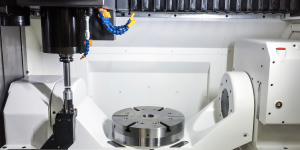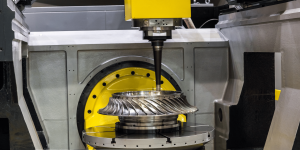CNC is an abbreviation for Computer Numerical Control, which are automated milling machines operated by computers. 5-axis CNC machines are equipped with five axes of motion on the cutting tool, and they are more versatile than the 3-axis machines in terms of operations that can be performed with them. The extra axes help the 5-axis CNC machines to come at various contours and, thus, are capable of cutting more intricate 3D shapes.
When evaluating 5-axis CNC machines, key factors to consider include:
Speed and Feed Rates
The ability of the tool to cut fast and the rate at which material is consumed are essential factors that have to be looked at when determining the productivity of the machine. Higher metal removal rates are achievable with higher speeds and feeds.

Precision and Accuracy
This implies that the movements of the machines and the actual parts that are machined must be exact. This means that machines involved in the production of products that have tighter tolerances are of higher accuracy.
Work Envelope Size
The extent of the workspace of the machine in which machining can be done influences the size of the parts that can be made. More oversized envelopes can accommodate more significant parts.
Power and Torque
The nature of the spindle motor determines how much power and torque is delivered at the cutting edge of the machine; this results in the ability to cut metals. More power results in more excellent material removal rates.
Automation Capabilities
Tool changer systems, pallet changer systems, and other features of automation enable increased productivity due to faster changeover times.
Comparing Best 5-Axis CNC Machines
Analysing some of the currently available 5-axis CNC machines for small- to medium-sized companies, one can see that there are fundamental parameters that define their machining capabilities and uses.
Haas UMC-500 SS
The UMC-500 SS is a versatile universal machining center ideal for 3+2 machining of small to medium-sized work pieces from Haas Automation.
Key Specs:
– 12,000 RPM Spindle
– Twenty horsepower vector drive
– 40+ Tool Magazine
– L 570/720 x W 368/450 x H 508/610 mm Work Envelope
The UMC-500 has very high spindle speeds, so it is very efficient in cutting aluminium. They also feature side-mount tool changer which enhances tool change rates. It is affordable and has 5 axes, but it occupies less space.

Mazak VARIAXIS j-600AM
The new generation 5-Axis Vertical Machining Centre VARIAXIS j-600AM from Mazak is fast and accurate.
Key Specs:
– 10,000 RPM Spindle
– 18. 4 Horsepower vector drive
– 120+ Tool Magazine
– W = 25. 6 x 21. 6 x 25. 6 in Work Envelope
Equipped with an extraordinary speed of 1,417 rpm, it possesses breathtakingly fast traverses with a dynamic VARIAXIS j-600AM. Integrex pallet system and the large tool magazine make it ideal for high productivity large batch machining.
Okuma GENOS M560-V
Okuma’s GENOS M560-V is a 5-axis vertical machining centre that offers a good surface finish.
Key Specs:
– 12,000 RPM Spindle
– 25 HP Vector Drive.
– 120 Tool Magazine
– 23. 8 x 27. 5 x 23. 6 inch Work Envelope
Other features such as Smooth Cutter Function and Smooth Surface Function make it possible for the GENOS M560-V to deliver smooth surface finishes. The Thermo-Friendly Concept ensures that the displacement due to temperature change is very minimal to enhance accuracy.
DMG MORI NLX2500SY/700
The DMG MORI NLX2500SY/700 is, in fact, a turn-mill hybrid that belongs to the group of NLX-integrated 5-axis turn-mill machining centers.
Key Specs:
– 12,000 RPM Spindle
– 25 HP Drive
– 20+ Tool Magazine
– Dimensions of Working Envelope: Length: 25. 6 inches Width: 25. 6 inches Height: 27. 5 inches
By having both turning and complete 5-axis milling in one machine, the NLX2500SY/700 is a very flexible machine. It can even do extensive and highly detailed parts right from one operation. Due to compactness, floorspace is conserved in any establishment that adopts the design.
Conclusion
As a result, when choosing a 5-axis CNC machine, factors such as size of the part, the material to be machined, surface finish required, accuracy level, and automation; should lead the buyers to the suitable machine for the intended production type. It is essential to understand that all the machines compared here belong to the same class, yet they all possess certain features that make them stand out. There is no single ‘best’ selection; instead, it is a matter of selecting the machine characteristics that are most appropriate for the application at hand.
